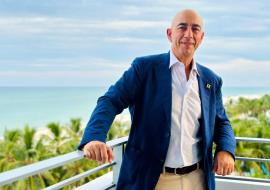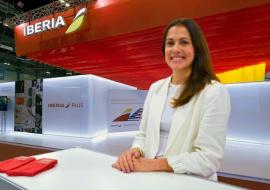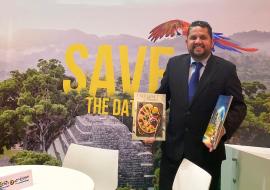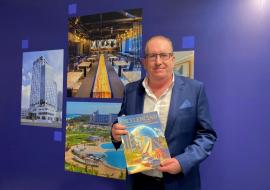Telemaco Talavera, Rector of Nicaragua’s Agricultural University
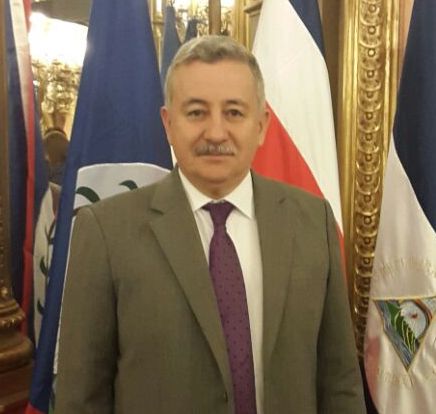
Within the framework of the International Tourism Fair (FITUR is the Spanish acronym), we talked to Telemaco Talavera, Rector of Nicaragua’s Agricultural University and representative of the new Interoceanic Canal that will join both the Pacific and Atlantic oceans through Nicaragua. During the dialogue, Talavera commented the potential of such Canal, which he labeled “largest civil work ever built in the world”, and praised the possibility of opening a Gastronomy Academy in his country.
What can the Nicaraguan travel industry offer to further develop tourism in the country?
Nicaragua has different options that range from beach tourism at the Pacific to offers targeting high-spending tourists. We have developed some top-of-the-line tourism complexes, such as the famous Guacalito. We have multiple options with small and big projects, we have sports tourism, the volcanic range with 25 volcanoes – 12 of which are active and stand as extraordinary tourism attractions –, tourism in nature reserves, a 20 thousand-square kilometer practically unexplored biosphere reserve, a 3,200-square kilometer biologic reserve with jaw-dropping diversity of wildlife. We also have the coffee route that includes cultural and landscape aspects; the cattle route, water route that includes lakes, lagoons, rivers; as well as historic and archaeological sites.
Nicaragua’s hotel infrastructure is very basic, is the any project to develop it?
Since 2007 the hotel offer has gone 121 percent up and the number of rooms has climbed in 93.5 percent; nevertheless, there is still a lot to be done and there are great opportunities for tourists.
How many rooms do you have?
We still have a limited capacity. That’s the reason why we’ve been contacting several Spanish investors, because that’s a very experienced country in the industry. There is huge potential when it comes to investing in the hotel infrastructure in unexplored areas of the Pacific and Caribbean. Nicaragua has great potential, but there is a lot to be done, which represents a true opportunity.
Airlift is a handicap for Nicaragua. Is there any plan or agreement with some airlines that make you receive more visitors?
We’re working to extend and bring the national airport up to date and, as part of the Grand Canal, Nicaragua is going to build the most state-of-the-art airport in Central America. We’re even establishing relations with different airlines from around the world. During my visit, I’m going to meet Iberia representatives, since we are interested in talking this airline into opening a non-stop flight to Nicaragua as we are going to have more capacity at the airport. We’re also going to contact other airlines.
How long are you going to take to build the Interoceanic Canal?
We have already started the works. Our time forecast is ambitious, but we believe that, with the present scientific and technological capabilities, in five years we’ll be able to tee off the operations in the canal. I mean that, by 2020, we’ll have the operational connection between the Pacific and the Atlantic, two deep-water ports, one airport, a free trade zone, financial and exports centers, seven tourism complexes throughout Nicaragua and, of course, a significant chain of investments. This is an important investment opportunity to the region, in order to reduce time and expenses.
What’s the investment for the Canal?
We have a 50,000 million dollar investment from different regions of the world. China gave a significant share, but there is also capital from Europe, Asia and the United States related to the construction of the Canal as main project, as well as derived projects.
Are the locks going to be bigger than Panama new canal?
The Panama Canal has capacity for vessels carrying 4,500 containers and that number will rise up to 13,100 with the new improvements. It’s an important growth; nonetheless the Nicaragua Canal will be able to deal with ships transporting up to 25 thousand containers, 400,000 tons of grains and 320,000 tons in the case of oil. Nicaragua’s locks are going to be the biggest on the planet.
The description of Nicaragua as a super ecologic country could be directly damaged by the construction of the canal and water transfers. How are you planning to stop that from happening?
Quite on the contrary, it’s an ecologic canal as it reduces distances and, therefore, the gases that would be emitted by vessels that are now going to cross Nicaragua. The project also includes the rethinking of hydrographic basin management, increased reforestation process and protection of our forest areas. The environmental impact is going to be focalized, but the overall result will be highly positive.
Nicaragua’s cuisine is excellent. Do you think that there is enough power and value in your country so as to create a foundation and open a Gastronomy Academy?
Yes, the extraordinary richness and diversity must be fostered through the national identity, but also in terms of the academy’s point of view, from governmental institutions and the private sector. We’re committed to creating a Gastronomy Academy in Nicaragua.








